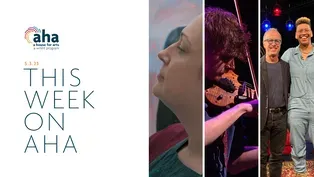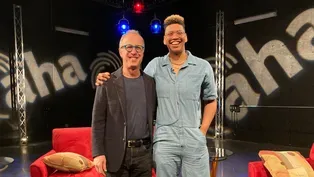
Amy Talluto's Magical Watercolor Collages
Clip: Season 8 Episode 26 | 6m 24sVideo has Closed Captions
Explore Amy Talluto's watercolor collages & her journey into a creative wonderland!
Join us as artist Amy Talluto discusses her evolution as an artist and how the pandemic influenced her work. Witness her transition from painting landscapes to experimenting with watercolor and collage, and discover her unique philosophy of using a 'constellation of seeds' to inspire her creations.
Problems with Closed Captions? Closed Captioning Feedback
Problems with Closed Captions? Closed Captioning Feedback
AHA! A House for Arts is a local public television program presented by WMHT
Support provided by the New York State Council on the Arts (NYSCA), M&T Bank, the Leo Cox Beach Philanthropic Foundation, and is also provided by contributors to the WMHT Venture...

Amy Talluto's Magical Watercolor Collages
Clip: Season 8 Episode 26 | 6m 24sVideo has Closed Captions
Join us as artist Amy Talluto discusses her evolution as an artist and how the pandemic influenced her work. Witness her transition from painting landscapes to experimenting with watercolor and collage, and discover her unique philosophy of using a 'constellation of seeds' to inspire her creations.
Problems with Closed Captions? Closed Captioning Feedback
How to Watch AHA! A House for Arts
AHA! A House for Arts is available to stream on pbs.org and the free PBS App, available on iPhone, Apple TV, Android TV, Android smartphones, Amazon Fire TV, Amazon Fire Tablet, Roku, Samsung Smart TV, and Vizio.
Providing Support for PBS.org
Learn Moreabout PBS online sponsorship(upbeat music) - I'm here in Hurley, New York to get a look inside the studio of artist Amy Talluto.
Let's go.
(upbeat music) - I was one of those people who comes out of the womb wanting to be an artist.
I just came out like that, and I've been being, I've been trying to be an artist since day one.
I've always loved drawing and painting and always just had that burning desire and drive to make stuff.
Well, I used to paint landscapes.
(gentle music) I feel like landscape has a real potential to transcend a more expected or decorative look.
For example, if you really look at trees when you're out and about, they look very bodily.
You can see a limb that looks like an arm or, you know, a knot will sort of give it almost like a facial characteristic.
They can look very alien.
And I find that personification if you will, of landscape very exciting.
And that has been my project for quite a long time.
But then I'm sure everyone has a similar story, but the pandemic hit, you know, and I was home with my son, and he was kind of young, too young to be self-directed.
So I was, you know, thought well, I can't make these large oil paintings anymore.
I have to work on a tabletop in the house.
So I started thinking to myself quite foolishly that I'll just do watercolor.
And actually, it turns out watercolor is the hardest medium on earth.
So needless to say, I was failing a lot, and mounding up a mountain of failed works.
And a friend suggested, why don't you collage those failures?
What do you have to lose?
And I thought, I don't know.
That sounds kind of crazy.
But then, you know, all bets are off.
It was the pandemic.
Nobody's watching, nobody cares.
And I started collaging things.
Spaces just presented themselves in a new exciting way, and things you wouldn't have even been able to come up with.
It was almost like the pile of debris suggested an image and you just had to kind of glue it down.
And that way of working was just so exciting to me.
When you go back to your studio after the pandemic, and you've been collaging, what do the paintings then look like?
How do you go back to painting?
You can't really go back to representational landscape.
Everything was sort of changed.
So in a way, I think that older work was a chapter that, or a book that closed.
And I, as the author, I finished the book and it's off.
And now I'm just sort of writing a new one.
(gentle music) I kind of follow a philosophy of a seed.
So every work has a constellation of seeds in it.
So for example, you might have a collage, and there's a portion of the collage that I think, Ah, that kinda looks like a face.
What if it grew legs and started walking around in the painting?
Or it could become a sculpture.
A painting of a beautiful woman with a blue satin dress.
I think it's called "The Princess de Broglie."
That is also a seed that I use in my work.
So I paint it in different ways.
Sometimes I just use the eyes or it could be something as simple as a tree I saw on a hike.
It kind of reared up from this bunch of rocks, and it had this cobra like look.
It was a dead tree and it was all smooth and white and had like a diamond shaped head.
And a central knot, like right in the center, like a nose.
That tree appears in many sculptures and paintings and collages as well.
(upbeat music) I think it's kind of fun to think of mediums in that way.
Like what if the gates come down and everybody mixes?
Sculptural characters can then go into a painting.
A character that's born from a collage or a painting, a 2D, can then find form in 3D.
And it's all kind of world building, and it creates this huge universe in the studio which I find exciting.
I like to think of like the children's game of telephone because for example you take that tree onto your lake, I whisper in someone's ear.
I saw this tree looks like a cobra with a diamond like head and a single orifice like a mouth.
And then by the time it gets through the sculptures and the paintings and all that sort of journey and gets repeated and repeated, it looks completely bananas.
And that's sort of the fun of it is to take a symbol and make it a character.
(upbeat music) I host a podcast, it's called "Pep Talks for Artists."
The podcast is a collection of audio essays, book reviews and also artist interviews.
The artist essays are sort of the heart of the podcast, and I write them for myself because being an artist sometimes feels like Lawrence of Arabia wandering in a desert of obscurity, and you just need an oasis sometimes.
You just need a little sip of water.
And so the podcast is sort of like my sip of water but it also offers that to others.
One of the lessons of putting yourself out there like that is that everybody feels the same.
The most, you know discouraged you feel or things that annoy you are almost certainly shared amongst everybody else.
So that's been a revelation.
It just helps you keep going when you get a little encouragement from any source.
You've been listening to "Pep Talks for Artists."
I really appreciate you stopping by, and I'll see you next time.
(upbeat music)
Video has Closed Captions
Preview: S8 Ep26 | 30s | Collage art, Black American art forms, and avant-garde violin music in this AHA! episode. (30s)
Albany Symphony's Journey to Celebrate Black American Art
Video has Closed Captions
Clip: S8 Ep26 | 10m 39s | Albany Symphony's David Alan Miller discusses Convergence. (10m 39s)
The Avant-Garde Violin Music of Connor Armbruster
Video has Closed Captions
Clip: S8 Ep26 | 6m 58s | Connor performs "The House Stood Empty" from his 2022 album, Masses. (6m 58s)
Providing Support for PBS.org
Learn Moreabout PBS online sponsorshipSupport for PBS provided by:
AHA! A House for Arts is a local public television program presented by WMHT
Support provided by the New York State Council on the Arts (NYSCA), M&T Bank, the Leo Cox Beach Philanthropic Foundation, and is also provided by contributors to the WMHT Venture...














